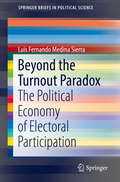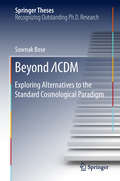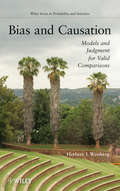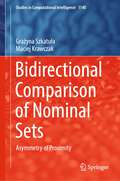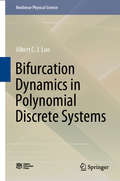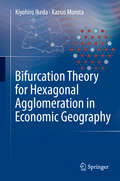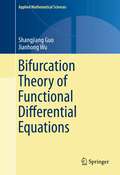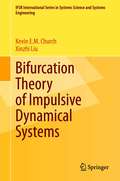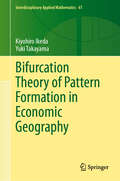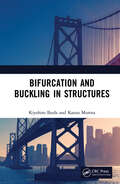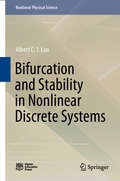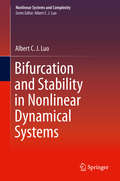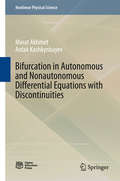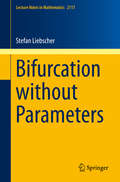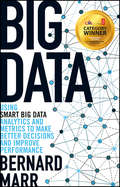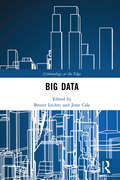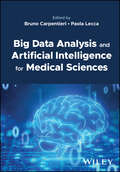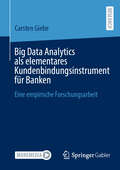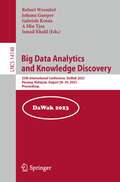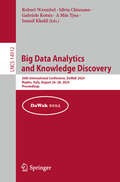- Table View
- List View
Beyond the Nanoworld: Quarks, Leptons, and Gauge Bosons
by H. G. DoschBeyond the world of atoms, at scales smaller than the smallest nuclei, a new world comes into view, populated by an array of colorful elementary particles: strange and charmed quarks, muons and neutrinos, gluons and photons, and many others, all interacting in beautifully intricate patterns. Beyond the Nanoworld tells the story of how this new real
Beyond the T-Test
by Scott A. PardoThis book was inspired by years of questions asked by non-statistical professionals, from social scientists, public policy analysts, regulatory affairs specialists, engineers, and physical scientists. It provides them with both an intuitive explanation of many common statistical methods and enough mathematical background to help them justify those methods to others, such as regulatory agencies. It provides an introduction to commonly used methods that are not covered in a first elementary statistics course, such as partial least squares, MCMC, and neural networks. It also provides R code for making all the computations described in the text. As a textbook, it could be used as a second course in statistics for non-statisticians, in fields such as social sciences, public policy, engineering, chemistry, and physics. Many first-year graduate students have had an elementary statistics course, but were not exposed to enough of the mathematics to justify the application of those methods. Furthermore, they often encounter methods and concepts not touched upon in their first statistics course. This book provides the tools required to give a deeper understanding of statistical methods without being all about theorems and proofs.
Beyond the Turnout Paradox
by Luis Fernando Medina SierraThis Brief uses game-theoretic analysis to debunk the turnout paradox and offers an alternative economic model to elucidate the patterns behind the socioeconomic bias in turnout. The author argues that the turnout paradox—the idea that rational, strategic actors would not vote in an election—is an overstated problem, and that, contrary to widespread belief, game-theoretic models of elections with highly realistic parameters are compatible with high turnout. The author applies the method of stability sets to the study of voting games so as to characterize the behavior of electoral turnout in response to the game’s structural parameters. To illustrate the power and potential of this framework, the author then develops a politico-economic model that generates testable theories about the way in which the modern welfare state and redistribution of wealth can shape the patterns of biased turnout that exist in most democracies. By turning a classic problem of rational choice into a source of new methods of analysis this Brief allows game theory to intervene in relevant conversations about the political economy of electoral participation, creating an opportunity for formal methods to make a welcome contribution to the discipline. As such, this Brief will be of use to scholars and student of political science, economics, political economy, and public policy, especially those who work in the tradition of formal methods.
Beyond ΛCDM: Exploring Alternatives To The Standard Cosmological Paradigm (Springer Theses)
by Sownak BoseThis book employs computer simulations of ‘artificial’ Universes to investigate the properties of two popular alternatives to the standard candidates for dark matter (DM) and dark energy (DE). It confronts the predictions of theoretical models with observations using a sophisticated semi-analytic model of galaxy formation. Understanding the nature of dark matter (DM) and dark energy (DE) are two of the most central problems in modern cosmology. While their important role in the evolution of the Universe has been well established—namely, that DM serves as the building blocks of galaxies, and that DE accelerates the expansion of the Universe—their true nature remains elusive. In the first half, the authors consider ‘sterile neutrino’ DM, motivated by recent claims that these particles may have finally been detected. Using sophisticated models of galaxy formation, the authors find that future observations of the high redshift Universe and faint dwarf galaxies in the Local Group can place strong constraints on the sterile neutrino scenario. In the second half, the authors propose and test novel numerical algorithms for simulating Universes with a ‘modified’ theory of gravity, as an alternative explanation to accelerated expansion. The authors’ techniques improve the efficiency of these simulations by more than a factor of 20 compared to previous methods, inviting the readers into a new era for precision cosmological tests of gravity.
Bias and Causation
by Herbert I. WeisbergA one-of-a-kind resource on identifying and dealing with bias in statistical research on causal effects Do cell phones cause cancer? Can a new curriculum increase student achievement? Determining what the real causes of such problems are, and how powerful their effects may be, are central issues in research across various fields of study. Some researchers are highly skeptical of drawing causal conclusions except in tightly controlled randomized experiments, while others discount the threats posed by different sources of bias, even in less rigorous observational studies. Bias and Causation presents a complete treatment of the subject, organizing and clarifying the diverse types of biases into a conceptual framework. The book treats various sources of bias in comparative studies--both randomized and observational--and offers guidance on how they should be addressed by researchers. Utilizing a relatively simple mathematical approach, the author develops a theory of bias that outlines the essential nature of the problem and identifies the various sources of bias that are encountered in modern research. The book begins with an introduction to the study of causal inference and the related concepts and terminology. Next, an overview is provided of the methodological issues at the core of the difficulties posed by bias. Subsequent chapters explain the concepts of selection bias, confounding, intermediate causal factors, and information bias along with the distortion of a causal effect that can result when the exposure and/or the outcome is measured with error. The book concludes with a new classification of twenty general sources of bias and practical advice on how mathematical modeling and expert judgment can be combined to achieve the most credible causal conclusions. Throughout the book, examples from the fields of medicine, public policy, and education are incorporated into the presentation of various topics. In addition, six detailed case studies illustrate concrete examples of the significance of biases in everyday research. Requiring only a basic understanding of statistics and probability theory, Bias and Causation is an excellent supplement for courses on research methods and applied statistics at the upper-undergraduate and graduate level. It is also a valuable reference for practicing researchers and methodologists in various fields of study who work with statistical data. This book was selected as the 2011 Ziegel Prize Winner in Technometrics for the best book reviewed by the journal. It is also the winner of the 2010 PROSE Award for Mathematics from The American Publishers Awards for Professional and Scholarly Excellence
Biased Sampling, Over-identified Parameter Problems and Beyond
by Jing QinThis book is devoted to biased sampling problems (also called choice-based sampling in Econometrics parlance) and over-identified parameter estimation problems. Biased sampling problems appear in many areas of research, including Medicine, Epidemiology and Public Health, the Social Sciences and Economics. The book addresses a range of important topics, including case and control studies, causal inference, missing data problems, meta-analysis, renewal process and length biased sampling problems, capture and recapture problems, case cohort studies, exponential tilting genetic mixture models etc.The goal of this book is to make it easier for Ph. D students and new researchers to get started in this research area. It will be of interest to all those who work in the health, biological, social and physical sciences, as well as those who are interested in survey methodology and other areas of statistical science, among others.
Bidirectional Comparison of Nominal Sets: Asymmetry of Proximity (Studies in Computational Intelligence #1140)
by Maciej Krawczak Grażyna SzkatułaThe authors propose a novel measure of proximity between two sets of nominal elements. This measure describes the changes in the first set after adding the second set or changes in the second set after adding the first set.It is crucial to note that this measure is not symmetric, it means that the perturbation of the first set on the second set can be different than the perturbation of the opposition direction. The introduced set impact measure allows for the direct treatment of objects described by nominal-valued attributes. The ordinary sets, multisets, fuzzy sets, and the intuitionistic fuzzy sets are considered. The book is intended for data science professionals, philosophers as well as cognitive psychologists, who struggle with practical problems in which asymmetry of proximity of objects cannot be neglected. The use of the proposed measures of perturbation between compared objects can be very important in data mining or in exploration of Internetresources.
Bifurcation Dynamics in Polynomial Discrete Systems (Nonlinear Physical Science)
by Albert C. LuoThis is the first book focusing on bifurcation dynamics in 1-dimensional polynomial nonlinear discrete systems. It comprehensively discusses the general mathematical conditions of bifurcations in polynomial nonlinear discrete systems, as well as appearing and switching bifurcations for simple and higher-order singularity period-1 fixed-points in the 1-dimensional polynomial discrete systems. Further, it analyzes the bifurcation trees of period-1 to chaos generated by period-doubling, and monotonic saddle-node bifurcations. Lastly, the book presents methods for period-2 and period-doubling renormalization for polynomial discrete systems, and describes the appearing mechanism and period-doublization of period-n fixed-points on bifurcation trees for the first time, offering readers fascinating insights into recent research results in nonlinear discrete systems.
Bifurcation Theory for Hexagonal Agglomeration in Economic Geography
by Kiyohiro Ikeda Kazuo MurotaThis book contributes to an understanding of how bifurcation theory adapts to the analysis of economic geography. It is easily accessible not only to mathematicians and economists, but also to upper-level undergraduate and graduate students who are interested in nonlinear mathematics. The self-organization of hexagonal agglomeration patterns of industrial regions was first predicted by the central place theory in economic geography based on investigations of southern Germany. The emergence of hexagonal agglomeration in economic geography models was envisaged by Krugman. In this book, after a brief introduction of central place theory and new economic geography, the missing link between them is discovered by elucidating the mechanism of the evolution of bifurcating hexagonal patterns. Pattern formation by such bifurcation is a well-studied topic in nonlinear mathematics, and group-theoretic bifurcation analysis is a well-developed theoretical tool. A finite hexagonal lattice is used to express uniformly distributed places, and the symmetry of this lattice is expressed by a finite group. Several mathematical methodologies indispensable for tackling the present problem are gathered in a self-contained manner. The existence of hexagonal distributions is verified by group-theoretic bifurcation analysis, first by applying the so-called equivariant branching lemma and next by solving the bifurcation equation. This book offers a complete guide for the application of group-theoretic bifurcation analysis to economic agglomeration on the hexagonal lattice.
Bifurcation Theory of Functional Differential Equations (Applied Mathematical Sciences #184)
by Jianhong Wu Shangjiang GuoThis book provides a crash course on various methods from the bifurcation theory of Functional Differential Equations (FDEs). FDEs arise very naturally in economics, life sciences and engineering and the study of FDEs has been a major source of inspiration for advancement in nonlinear analysis and infinite dimensional dynamical systems. The book summarizes some practical and general approaches and frameworks for the investigation of bifurcation phenomena of FDEs depending on parameters with chap. This well illustrated book aims to be self contained so the readers will find in this book all relevant materials in bifurcation, dynamical systems with symmetry, functional differential equations, normal forms and center manifold reduction. This material was used in graduate courses on functional differential equations at Hunan University (China) and York University (Canada).
Bifurcation Theory of Impulsive Dynamical Systems (IFSR International Series in Systems Science and Systems Engineering #34)
by Xinzhi Liu Kevin E.M. ChurchThis monograph presents the most recent progress in bifurcation theory of impulsive dynamical systems with time delays and other functional dependence. It covers not only smooth local bifurcations, but also some non-smooth bifurcation phenomena that are unique to impulsive dynamical systems. The monograph is split into four distinct parts, independently addressing both finite and infinite-dimensional dynamical systems before discussing their applications. The primary contributions are a rigorous nonautonomous dynamical systems framework and analysis of nonlinear systems, stability, and invariant manifold theory. Special attention is paid to the centre manifold and associated reduction principle, as these are essential to the local bifurcation theory. Specifying to periodic systems, the Floquet theory is extended to impulsive functional differential equations, and this permits an exploration of the impulsive analogues of saddle-node, transcritical, pitchfork and Hopf bifurcations.Readers will learn how techniques of classical bifurcation theory extend to impulsive functional differential equations and, as a special case, impulsive differential equations without delays. They will learn about stability for fixed points, periodic orbits and complete bounded trajectories, and how the linearization of the dynamical system allows for a suitable definition of hyperbolicity. They will see how to complete a centre manifold reduction and analyze a bifurcation at a nonhyperbolic steady state.
Bifurcation Theory of Pattern Formation in Economic Geography (Interdisciplinary Applied Mathematics #61)
by Kiyohiro Ikeda Yuki TakayamaDive into the fascinating world of economic agglomerations with this interdisciplinary study, which is perfect for readers in nonlinear mathematics, economic geography, and spatial economics. This book uniquely bridges these fields, employing group-theoretic bifurcation analysis in nonlinear mathematics to establish a robust theoretical foundation for economic geographers and mathematicians alike. Explore innovative models that describe the pattern formation in economic agglomerations through worker migration between regions. Delve into multi-regional formulations of classic economic geography models, applied to various spatial platforms such as line segments, racetracks, squares, and hexagonal lattices. This book, ideal for researchers and practitioners, offers cutting-edge insights and methodologies for understanding the complexities of spatial economic agglomerations.
Bifurcation and Buckling in Structures
by Kiyohiro Ikeda Kazuo MurotaBifurcation and Buckling in Structures describes the theory and analysis of bifurcation and buckling in structures. Emphasis is placed on a general procedure for solving nonlinear governing equations and an analysis procedure related to the finite-element method. Simple structural examples using trusses, columns, and frames illustrate the principles. Part I presents fundamental issues such as the general mathematical framework for bifurcation and buckling, procedures for the buckling load/mode analyses, and numerical analysis procedures to trace the solution curves and switch to bifurcation solutions. Advanced topics include asymptotic theory of bifurcation and bifurcation theory of symmetric systems. Part II deals with buckling of perfect and imperfect structures. An overview of the member buckling of columns and beams is provided, followed by the buckling analysis of truss and frame structures. The worst and random imperfections are studied as advanced topics. An extensive review of the history of buckling is presented. This text is ideal for advanced undergraduate and graduate students in engineering and applied mathematics. To assist readers, problems are listed at the end of each chapter, and their answers are given at the end of the book. Kiyohiro Ikeda is Professor Emeritus at Tohoku University, Japan. Kazuo Murota is a Project Professor at the Institute of Statistical Mathematics, Japan, as well as Professor Emeritus at the University of Tokyo, Kyoto University, and Tokyo Metropolitan University, Japan.
Bifurcation and Stability in Nonlinear Discrete Systems (Nonlinear Physical Science)
by Albert C. LuoThis book focuses on bifurcation and stability in nonlinear discrete systems, including monotonic and oscillatory stability. It presents the local monotonic and oscillatory stability and bifurcation of period-1 fixed-points on a specific eigenvector direction, and discusses the corresponding higher-order singularity of fixed-points. Further, it explores the global analysis of monotonic and oscillatory stability of fixed-points in 1-dimensional discrete systems through 1-dimensional polynomial discrete systems. Based on the Yin-Yang theory of nonlinear discrete systems, the book also addresses the dynamics of forward and backward nonlinear discrete systems, and the existence conditions of fixed-points in said systems. Lastly, in the context of local analysis, it describes the normal forms of nonlinear discrete systems and infinite-fixed-point discrete systems. Examining nonlinear discrete systems from various perspectives, the book helps readers gain a better understanding of the nonlinear dynamics of such systems.
Bifurcation and Stability in Nonlinear Dynamical Systems (Nonlinear Systems and Complexity #28)
by Albert C. LuoThis book systematically presents a fundamental theory for the local analysis of bifurcation and stability of equilibriums in nonlinear dynamical systems. Until now, one does not have any efficient way to investigate stability and bifurcation of dynamical systems with higher-order singularity equilibriums. For instance, infinite-equilibrium dynamical systems have higher-order singularity, which dramatically changes dynamical behaviors and possesses the similar characteristics of discontinuous dynamical systems. The stability and bifurcation of equilibriums on the specific eigenvector are presented, and the spiral stability and Hopf bifurcation of equilibriums in nonlinear systems are presented through the Fourier series transformation. The bifurcation and stability of higher-order singularity equilibriums are presented through the (2m)th and (2m+1)th -degree polynomial systems. From local analysis, dynamics of infinite-equilibrium systems is discussed. The research on infinite-equilibrium systems will bring us to the new era of dynamical systems and control. Presents an efficient way to investigate stability and bifurcation of dynamical systems with higher-order singularity equilibriums;Discusses dynamics of infinite-equilibrium systems;Demonstrates higher-order singularity.
Bifurcation in Autonomous and Nonautonomous Differential Equations with Discontinuities (Nonlinear Physical Science)
by Marat Akhmet Ardak KashkynbayevThis book is devoted to bifurcation theory for autonomous and nonautonomous differential equations with discontinuities of different types. That is, those with jumps present either in the right-hand-side or in trajectories or in the arguments of solutions of equations. The results obtained in this book can be applied to various fields such as neural networks, brain dynamics, mechanical systems, weather phenomena, population dynamics, etc. Without any doubt, bifurcation theory should be further developed to different types of differential equations. In this sense, the present book will be a leading one in this field. The reader will benefit from the recent results of the theory and will learn in the very concrete way how to apply this theory to differential equations with various types of discontinuity. Moreover, the reader will learn new ways to analyze nonautonomous bifurcation scenarios in these equations. The book will be of a big interest both for beginners and experts in the field. For the former group of specialists, that is, undergraduate and graduate students, the book will be useful since it provides a strong impression that bifurcation theory can be developed not only for discrete and continuous systems, but those which combine these systems in very different ways. The latter group of specialists will find in this book several powerful instruments developed for the theory of discontinuous dynamical systems with variable moments of impacts, differential equations with piecewise constant arguments of generalized type and Filippov systems. A significant benefit of the present book is expected to be for those who consider bifurcations in systems with impulses since they are presumably nonautonomous systems.
Bifurcation without Parameters (Lecture Notes in Mathematics #2117)
by Stefan LiebscherTargeted at mathematicians having at least a basic familiarity with classical bifurcation theory, this monograph provides a systematic classification and analysis of bifurcations without parameters in dynamical systems. Although the methods and concepts are briefly introduced, a prior knowledge of center-manifold reductions and normal-form calculations will help the reader to appreciate the presentation. Bifurcations without parameters occur along manifolds of equilibria, at points where normal hyperbolicity of the manifold is violated. The general theory, illustrated by many applications, aims at a geometric understanding of the local dynamics near the bifurcation points.
Big Data
by Bernard MarrConvert the promise of big data into real world resultsThere is so much buzz around big data. We all need to know what it is and how it works - that much is obvious. But is a basic understanding of the theory enough to hold your own in strategy meetings? Probably. But what will set you apart from the rest is actually knowing how to USE big data to get solid, real-world business results - and putting that in place to improve performance. Big Data will give you a clear understanding, blueprint, and step-by-step approach to building your own big data strategy. This is a well-needed practical introduction to actually putting the topic into practice. Illustrated with numerous real-world examples from a cross section of companies and organisations, Big Data will take you through the five steps of the SMART model: Start with Strategy, Measure Metrics and Data, Apply Analytics, Report Results, Transform.Discusses how companies need to clearly define what it is they need to knowOutlines how companies can collect relevant data and measure the metrics that will help them answer their most important business questionsAddresses how the results of big data analytics can be visualised and communicated to ensure key decisions-makers understand themIncludes many high-profile case studies from the author's work with some of the world's best known brands
Big Data (Criminology at the Edge)
by Benoit Leclerc Jesse CaleThe internet has launched the world into an era into which enormous amounts of data are generated every day through technologies with both positive and negative consequences. This often refers to big data . This book explores big data in organisations operating in the criminology and criminal justice fields. Big data entails a major disruption in the ways we think about and do things, which certainly applies to most organisations including those operating in the criminology and criminal justice fields. Big data is currently disrupting processes in most organisations – how different organisations collaborate with one another, how organisations develop products or services, how organisations can identify, recruit, and evaluate talent, how organisations can make better decisions based on empirical evidence rather than intuition, and how organisations can quickly implement any transformation plan, to name a few. All these processes are important to tap into, but two underlying processes are critical to establish a foundation that will permit organisations to flourish and thrive in the era of big data – creating a culture more receptive to big data and implementing a systematic data analytics-driven process within the organisation. Written in a clear and direct style, this book will appeal to students and scholars in criminology, criminal justice, sociology, and cultural studies but also to government agencies, corporate and non-corporate organisations, or virtually any other institution impacted by big data.
Big Data Analysis and Artificial Intelligence for Medical Sciences
by Paola Lecca Bruno CarpentieriBig Data Analysis and Artificial Intelligence for Medical Sciences Overview of the current state of the art on the use of artificial intelligence in medicine and biology Big Data Analysis and Artificial Intelligence for Medical Sciences demonstrates the efforts made in the fields of Computational Biology and medical sciences to design and implement robust, accurate, and efficient computer algorithms for modeling the behavior of complex biological systems much faster than using traditional modeling approaches based solely on theory. With chapters written by international experts in the field of medical and biological research, Big Data Analysis and Artificial Intelligence for Medical Sciences includes information on: Studies conducted by the authors which are the result of years of interdisciplinary collaborations with clinicians, computer scientists, mathematicians, and engineers Differences between traditional computational approaches to data processing (those of mathematical biology) versus the experiment-data-theory-model-validation cycle Existing approaches to the use of big data in the healthcare industry, such as through IBM’s Watson Oncology, Microsoft’s Hanover, and Google’s DeepMind Difficulties in the field that have arisen as a result of technological changes, and potential future directions these changes may take A timely and up-to-date resource on the integration of artificial intelligence in medicine and biology, Big Data Analysis and Artificial Intelligence for Medical Sciences is of great benefit not only to professional scholars, but also MSc or PhD program students eager to explore advancement in the field.
Big Data Analysis for Bioinformatics and Biomedical Discoveries (Chapman & Hall/CRC Computational Biology Series)
by Shui Qing YeDemystifies Biomedical and Biological Big Data AnalysesBig Data Analysis for Bioinformatics and Biomedical Discoveries provides a practical guide to the nuts and bolts of Big Data, enabling you to quickly and effectively harness the power of Big Data to make groundbreaking biological discoveries, carry out translational medical research, and implem
Big Data Analytics als elementares Kundenbindungsinstrument für Banken: Eine empirische Forschungsarbeit
by Carsten GiebeDie vorliegenden Untersuchungen schließen nicht nur eine bestehende Lücke in der akademischen Diskussion zu Big Data Analytics im deutschen Bankwesen, sondern tragen auch zu praktischem Wissen aus verschiedenen Blickwinkeln bei. Erstmalig wurde für Banken in Deutschland der Bezug zwischen dem Modell „Grundsätze der Kundenberatung“ im Zusammenhang mit Big Data Analytics aus der Bankkundenperspektive und der Bankberaterperspektive untersucht. Der Hauptbeitrag dieser Forschung und ihre Originalität bilden Ergebnisse, um den Einsatz von Big Data Analytics als elementares Kundenbindungsinstrument für Banken in Deutschland besser zu verstehen und Richtungen aufzuzeigen, diesen zu nutzen bzw. auszubauen.
Big Data Analytics and Knowledge Discovery: 24th International Conference, DaWaK 2022, Vienna, Austria, August 22–24, 2022, Proceedings (Lecture Notes in Computer Science #13428)
by Ismail Khalil A Min Tjoa Johann Gamper Robert Wrembel Gabriele KotsisThis volume LNCS 13428 constitutes the papers of the 24 th International Conference on Big Data Analytics and Knowledge Discovery, held in August 2022 in Vienna, Austria. The 12 full papers presented together with 12 short papers in this volume were carefully reviewed and selected from a total of 57 submissions. The papers reflect a wide range of topics in the field of data integration, data warehousing, data analytics, and recently big data analytics, in a broad sense. The main objectives of this event are to explore, disseminate, and exchange knowledge in these fields.
Big Data Analytics and Knowledge Discovery: 25th International Conference, DaWaK 2023, Penang, Malaysia, August 28–30, 2023, Proceedings (Lecture Notes in Computer Science #14148)
by Ismail Khalil A Min Tjoa Johann Gamper Robert Wrembel Gabriele KotsisThis book constitutes the proceedings of the 25th International Conference on Big Data Analytics and Knowledge Discovery, DaWaK 2023, which took place in Penang, Malaysia, during August 29-30, 2023. The 18 full papers presented together with 19 short papers were carefully reviewed and selected from a total of 83 submissions. They were organized in topical sections as follows: Data quality; advanced analytics and pattern discovery; machine learning; deep learning; and data management.
Big Data Analytics and Knowledge Discovery: 26th International Conference, DaWaK 2024, Naples, Italy, August 26–28, 2024, Proceedings (Lecture Notes in Computer Science #14912)
by Ismail Khalil A Min Tjoa Robert Wrembel Silvia Chiusano Gabriele KotsisThis book constitutes the proceedings of the 26th International Conference on Big Data Analytics and Knowledge Discovery, DaWaK 2024, which too place in Naples, Italy, during August 26-28, 2024. The 16 full and 20 short papers included in this book were carefully reviewed and selected from 83 submissions. They were organized in topical sections as follows: Modeling and design; entity matching and similarity; classification; machine learning methods and applications; time series; data repositories;optimization; and data quality and applications.


